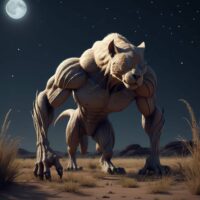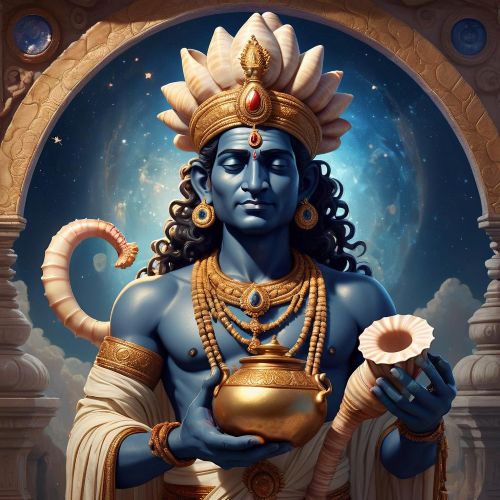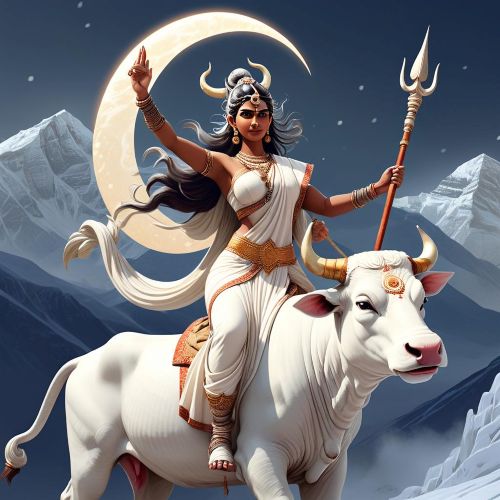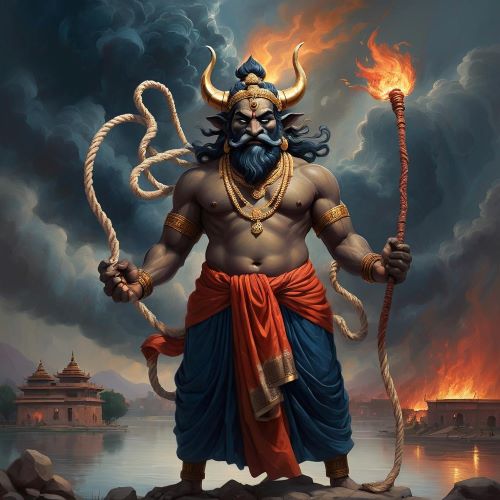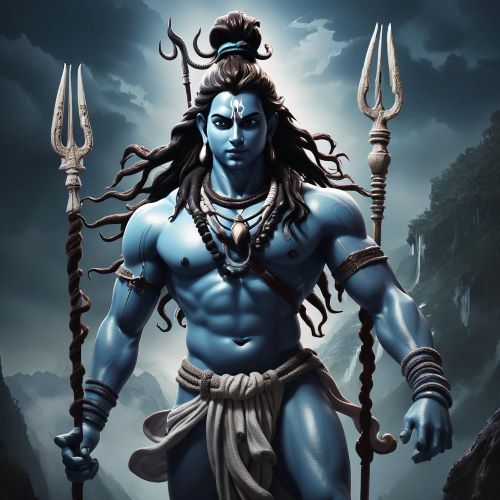Ardhanarishwar : The Dual Gender God
Listen
At a glance
| Description | |
|---|---|
| Origin | Indian Mythology |
| Classification | Gods |
| Family Members | Shiva and Parvathi (One half each) |
| Region | India |
| Associated With | Union of Genders |
Ardhanarishwar
Introduction
Ardhanarishwar, meaning “The Lord Who is Half Woman,” is one of the most iconic and philosophically rich deities in Hindu mythology. This composite form of Lord Shiva and Goddess Parvati represents the eternal unity of masculine and feminine energies. Far more than just an artistic concept, Ardhanarishwar stands as a spiritual symbol of balance, duality, and cosmic harmony. The union of Shiva (Purusha) and Shakti (Prakriti) in one form signifies that creation is only possible through the integration of opposites. This powerful representation of gender and energy dates back to early Indian art from the Kushan and Gupta periods, and its influence has endured through the centuries in religious, philosophical, and artistic expressions across the Indian subcontinent.
Physical Traits
The form of Ardhanarishwar is visually striking and symbolically loaded. The deity is depicted as a vertically split figure—Shiva on the right and Parvati on the left. Each half has distinct characteristics, yet the overall image radiates unity and divine equilibrium.
Shiva’s side is marked by ascetic elements: matted hair adorned with the crescent moon, the flowing river Ganga, and the presence of serpents. His muscular torso, ash-covered skin, and symbolic third eye reflect detachment, inner vision, and divine power. He may hold a trident or a rosary, reinforcing his role as both a destroyer of ignorance and a master of spiritual knowledge.
Parvati’s side exudes grace and fertility. Her form includes curvaceous features, soft skin, and richly adorned garments. Ornaments like bangles, anklets, and necklaces highlight her feminine beauty and nurturing nature. Often, she holds a lotus, mirror, or parrot—symbols of love, self-reflection, and creative speech. Together, these halves illustrate the harmonious coexistence of strength and softness, action and compassion, spirit and matter.
Family
Ardhanarishwar is not a separate deity but a symbolic fusion of Shiva and Parvati, the divine couple revered throughout Hinduism. Their union is considered the cosmic blueprint for creation. Parvati is said to be the reincarnation of Sati, Shiva’s first wife, and through intense devotion and penance, she rejoined Shiva as his equal and divine consort.
As Ardhanarishwar, their bond goes beyond marriage—it becomes an eternal truth that underlines the necessity of both masculine and feminine energies for the universe to function. From their sacred union emerged their sons: Ganesha, the remover of obstacles and god of wisdom, and Kartikeya, the fierce warrior and leader of celestial armies. In some traditions, they are also said to have a daughter named Ashoksundari.
The symbolism behind Ardhanarishwar reinforces that no aspect of life—spiritual or material—can thrive without equilibrium between opposing yet complementary forces.
Other names
The deity Ardhanarishwar is referred to by various names across different regions and scriptures, each highlighting a unique facet of this divine form. These names not only reflect cultural variations but also emphasize different philosophical interpretations.
Names like Ardhanaranari and Ardhanarisha focus on the balanced split between male and female elements. Ardhanarinateshwar links the deity with Shiva’s identity as Nataraja, the cosmic dancer, emphasizing the union’s dynamic and rhythmic nature.
In Tamil culture, the deity is lovingly called Ammaiyappan, meaning “Mother-Father.” In Assam, the name Ardhayuvatishvara is used, which means “Lord whose half is a young woman,” emphasizing youthful energy and creation. Other names like Naranari, Parangada, Gaurishvara, and Ardha-Gaurishvara appear in classical texts and iconographic manuals, offering deeper insights into the deity’s layered symbolism.
Each name reinforces the core idea that Ardhanarishwar is the embodiment of divine duality and inseparability.
Powers and Abilities
The powers of Ardhanarishwar lie in the perfect equilibrium of opposites—Shiva’s conscious stillness and Parvati’s dynamic energy. This union serves as a metaphysical foundation for all creation, preservation, and transformation in the universe. Ardhanarishwar is not just a symbolic representation of harmony; it is a living principle in Tantra and Yogic traditions, where balance between masculine and feminine forces leads to enlightenment.
In the Shiva Purana, Brahma is shown as being unable to create the world until Shiva manifests as Ardhanarishwar to reveal the necessity of feminine energy. From this form, Parvati generates various goddesses, enabling the divine cycle of life to begin. This episode shows that Shiva without Shakti is powerless—just as Shakti without Shiva is directionless.
Spiritually, Ardhanarishwar teaches the importance of integrating different aspects of the self. Devotees chant the Ardhanarishwar Stotram to gain emotional balance, spiritual insight, and fulfillment. This form of Shiva and Parvati inspires seekers to overcome duality and achieve wholeness by uniting intellect with emotion, willpower with intuition, and action with compassion.
Modern Day Influence
Ardhanarishwar’s impact in the modern world extends far beyond temples and scriptures. The deity has become a powerful symbol in contemporary conversations around gender identity, equality, and spiritual balance. As societies move towards a broader understanding of gender fluidity and inclusivity, Ardhanarishwar offers a timeless message: that true strength comes from balance and integration, not division.
This concept has made its way into modern art, literature, and performance. In classical Indian dance forms like Bharatanatyam and Odissi, performers embody Ardhanarishwar through choreography that flows between masculine and feminine energy. Contemporary artists continue to draw inspiration from this form to challenge gender norms and highlight the richness of the human experience.
In psychology and personal development, the Ardhanarishwar archetype aligns closely with Jungian ideas of the anima and animus—inner representations of the opposite gender that must be reconciled for psychological wholeness. In yogic disciplines, the union of Shiva and Shakti through Kundalini awakening mirrors the spiritual ideal symbolized by Ardhanarishwar.
Even popular culture—from films to digital art—often borrows from this imagery to explore the balance of opposites. Whether interpreted through the lens of mythology, gender discourse, or spirituality, Ardhanarishwar remains a deeply relevant figure in both traditional and modern contexts.
Related Images
Source
Ardhanareeshwara Concept: Brain and Psychiatry – PMC. (n.d.). PMC. Retrieved from https://pmc.ncbi.nlm.nih.gov/articles/PMC3705693/
Ardhanarishvara – Wikipedia. (n.d.). Wikipedia. Retrieved from https://en.wikipedia.org/wiki/Ardhanarishvara
Ardhanarishvara: The Androgynous Form of Shiva | by Exotic India. (2024, July 23). Medium. Retrieved from https://medium.com/@exoticindiaa/ardhanarishvara-the-androgynous-form-of-shiva-12d00a321bf4
Ardhanarishvara – When the Ultimate Man Became Half-Woman. (2014, June 22). isha.sadhguru.org. Retrieved from https://isha.sadhguru.org/en/wisdom/article/ardhanarishvara
Ardhanarishvara | Androgynous Form, Shiva-Shakti & Hinduism. (1998, July 20). Britannica. Retrieved from https://www.britannica.com/topic/Ardhanarishvara
Ardhanarishwara: Meaning, Symbolism and Interpretations. (2010, March 1). isharethese.com. Retrieved from https://isharethese.com/ardhanarishwara-meaning-statues-concept-story-photos/
Ardha Narishvara Stotram – With Lyrics, Audio, Meaning, … (2023, March 9). shlokam.org. Retrieved from https://shlokam.org/ardha-narishvara-stotram/
The Hindu Theology of Ardhanarīśvara, the Queer God. (2019, August 8). Medium. Retrieved from https://shashankrao-84497.medium.com/the-theology-of-ardhanar%C4%AB%C5%9Bvara-the-queer-god-dd2a6aa3eda5
The Tale of Ardhanarishvara: The Union of Shiva and Parvati. (2024, November 26). omspiritualshop.com. Retrieved from https://www.omspiritualshop.com/blogs/news/the-tale-of-ardhanarishvara-the-union-of-shiva-and-parvati?srsltid=AfmBOoor94AK0OkdLY9ibnm2VVyzGGegbG3XtWV_zvwCLjVcJMSLx0Cl
Frequently Asked Questions
What is lorem Ipsum?
I am text block. Click edit button to change this text. Lorem ipsum dolor sit amet, consectetur adipiscing elit. Ut elit tellus, luctus nec ullamcorper mattis, pulvinar dapibus leo.
What is lorem Ipsum?
I am text block. Click edit button to change this text. Lorem ipsum dolor sit amet, consectetur adipiscing elit. Ut elit tellus, luctus nec ullamcorper mattis, pulvinar dapibus leo.
What is lorem Ipsum?
I am text block. Click edit button to change this text. Lorem ipsum dolor sit amet, consectetur adipiscing elit. Ut elit tellus, luctus nec ullamcorper mattis, pulvinar dapibus leo.
What is lorem Ipsum?
I am text block. Click edit button to change this text. Lorem ipsum dolor sit amet, consectetur adipiscing elit. Ut elit tellus, luctus nec ullamcorper mattis, pulvinar dapibus leo.
What is lorem Ipsum?
I am text block. Click edit button to change this text. Lorem ipsum dolor sit amet, consectetur adipiscing elit. Ut elit tellus, luctus nec ullamcorper mattis, pulvinar dapibus leo.


